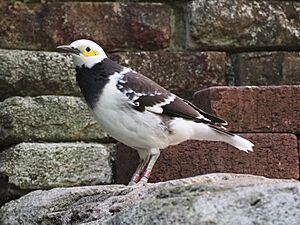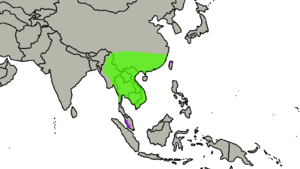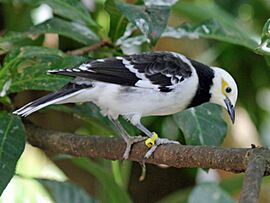Black-collared starling facts for kids
Quick facts for kids Black-collared starling |
|
|---|---|
 |
|
| Conservation status | |
| Scientific classification | |
| Genus: |
Gracupica
|
| Species: |
nigricollis
|
 |
|
| Green: Extant (resident), Purple: Extant (resident and introduced) | |
| Synonyms | |
|
Sturnus nigricollis |
|
The black-collared starling (Gracupica nigricollis) is a type of starling bird. It belongs to the Sturnidae family. This bird is easy to spot with its black and white feathers and a special black "collar" around its neck. You can find it in southern China and many parts of Southeast Asia. It has also been brought to places like Taiwan, Malaysia, and Singapore. These starlings like to live in grasslands, dry forests, and even near towns where people live. The International Union for Conservation of Nature (IUCN) says this bird is "least concern," meaning it's not in danger.
Contents
About the Black-collared Starling
What's in a Name?
This bird was first named Gracula nigricollis by a scientist named Gustaf von Paykull in 1807. For a while, it was grouped with other birds in the Sturnus family. But in 2008, after scientists studied bird families more closely, the black-collared starling and the Siamese pied myna were moved to their own group called Gracupica. This helps scientists understand how different birds are related.
What Does It Look Like?
The black-collared starling is about 26 to 30 centimeters (about 10 to 12 inches) long. Its head is white, and it has a bright yellow patch of skin around its eyes. A clear black band, like a collar, goes around its neck.
Its back, shoulders, and wings are dark brown, almost black. The belly and chest are white, sometimes with a bit of grey-brown color. The tips of its tail feathers and most wing feathers are white. Its beak is black, and its legs are light grey. Male and female starlings look very similar. Young starlings are browner and have streaks on their neck and chest. They have the eye patch but not the black collar.
Where Do They Live?
You can find the black-collared starling in southern China, from Fujian to Yunnan. They also live south in countries like Burma, Laos, Cambodia, Vietnam, and Thailand. Sometimes, one might be seen in Brunei, but it could be a bird that escaped from a cage or just got lost.
These starlings have also been introduced to Taiwan, Malaysia, and Singapore. This means people brought them there, and now they live in the wild. They prefer open areas like grasslands, dry forests, and farms. They also live in places where people have settled. They usually live in low areas, but can be found up to 2,000 meters (about 6,500 feet) high.
How Black-collared Starlings Behave

What Do They Eat?
These starlings often look for food on the ground. They sometimes search near farm animals. Their diet includes insects, earthworms, and seeds.
Their Calls and Songs
Black-collared starlings are very noisy birds. They make many different sounds. Their calls can be shrill, harsh, or even melodious. Some sounds are like a jay's "kraak kraak." Others are a whistling "prrü," similar to a bee-eater. They also make a "pü-pü-pü-pü" sound. Their song is described as "tcheeuw-tchew-trieuw."
Courtship and Nesting
When a male and female starling are ready to mate, they do special dances. One dance involves them facing each other, fluffing up their feathers, and opening their beaks. In another dance, they drop their wings and bow their heads. Between these dances, they might chase each other. They also preen each other, which means they clean each other's feathers. This is a way for them to bond.
The breeding season happens at different times depending on the location. It's from February to May in Thailand, March to July in China, and April to August in Burma. They build large, dome-shaped nests from twigs, grasses, feathers, and flowers. These nests are usually built in trees and can be used again. Sometimes, many starlings build their nests close together in colonies. A female starling usually lays three to five eggs at a time.
Conservation Status
The black-collared starling is doing well. In fact, cutting down some forests (deforestation) has actually helped this bird. It has allowed them to spread to new areas. Their numbers seem to be growing. Because of this, the IUCN has listed the black-collared starling as a least-concern species. This means scientists are not worried about it becoming endangered.


